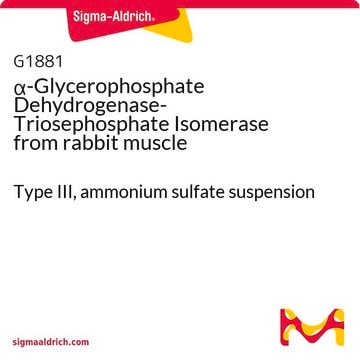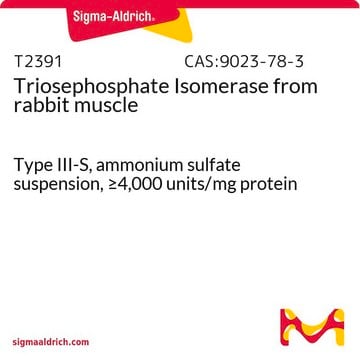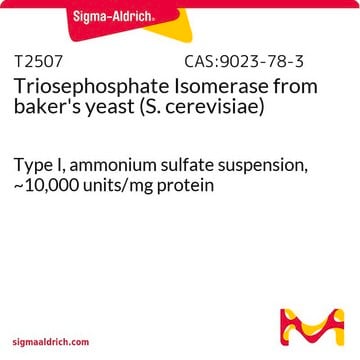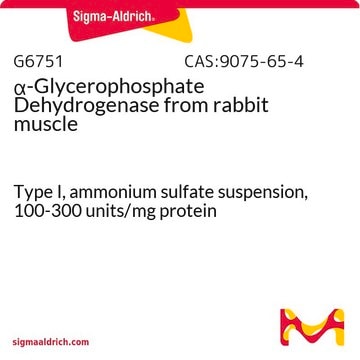推荐产品
種類
Type X
形狀
lyophilized powder
比活性
≥3,500 units/mg protein
分子量
calculated mol wt 53.2 kDa
成份
Protein, 60-90% biuret
異物活動
pyruvate kinase, lactic dehydrogenase, 3-phosphoglyceric phosphokinase, phosphoglucose isomerase, α-glycerophosphate dehydrogenase, aldolase and glyceraldehyde-3-phosphate dehydrogenase ≤0.01%
儲存溫度
−20°C
正在寻找类似产品? 访问 产品对比指南
相关类别
一般說明
磷酸丙糖异构酶(TPI)的基因位于人类12p13染色体上。它在所有组织中都有表达。其是由两个27 kDa亚基组成的同型二聚体,具有高度稳定性,由248个氨基酸组成。TPI在其二聚状态下具有催化活性。
應用
来自兔肌肉的磷酸丙糖异构酶可与 p-羟基苯甲酸汞(PHMB)形成复合物,使蛋白质变性,从而进行疏水相互作用色谱,并在线与化学气相色谱-荧光光谱法(HIC−CVGAFS)耦合。
磷酸丙糖异构酶已被用于研究高脂饮食喂养的超重大鼠中心脏能量代谢途径的变化。 磷酸丙糖异构酶已被用于研究在1-溴丙烷暴露后F344大鼠海马体中羰基化蛋白的蛋白质组学鉴定。
生化/生理作用
磷酸丙糖异构酶(TPI)负责磷酸三糖异构体、磷酸二羟基丙酮和3-磷酸甘油醛的催化。 TPI缺乏与糖酵解酶病有关。 TPI的缺乏还与慢性溶血性贫血、细菌暴露感染、心肌病和神经肌肉疾病有关。
包裝
包装尺寸基于蛋白质含量
單位定義
一个酶活性单位是指在pH 7.6、温度25 °C条件下,每分钟将1.0 μmole的D-甘油醛-3-磷酸转化为二羟丙酮磷酸所需的酶量。
外觀
不含硫酸盐,含EDTA和硼酸盐缓冲盐
儲存類別代碼
11 - Combustible Solids
水污染物質分類(WGK)
WGK 3
閃點(°F)
Not applicable
閃點(°C)
Not applicable
個人防護裝備
Eyeshields, Gloves, type N95 (US)
其他客户在看
Red blood cell enzymopathies
Hematology, 616-625 (2018)
Changes in cardiac energy metabolic pathways in overweighed rats fed a high-fat diet
Modrego, J., et al.
European Journal of Nutrition, DOI: 10-DOI: 10 (2012)
Triosephosphate isomerase deficiency: new insights into an enigmatic disease
Orosz F, et al.
Biochimica et Biophysica Acta (BBA)-Molecular Basis of Disease, 1792(12), 1168-1174 (2009)
Hydrophobic interaction chromatography coupled with atomic fluorescence spectrometric detection: Effect of the denaturation on the determination of thiolic proteins
Bramanti E, et al.
Talanta, 63(2), 383-389 (2004)
Zhenlie Huang et al.
Toxicology and applied pharmacology, 263(1), 44-52 (2012-06-12)
1-Bromopropane (1-BP) is neurotoxic in both experimental animals and humans. Previous proteomic analysis of rat hippocampus implicated alteration of protein expression in oxidative stress, suggesting that oxidative stress plays a role in 1-BP-induced neurotoxicity. To understand this role at the
我们的科学家团队拥有各种研究领域经验,包括生命科学、材料科学、化学合成、色谱、分析及许多其他领域.
联系技术服务部门













